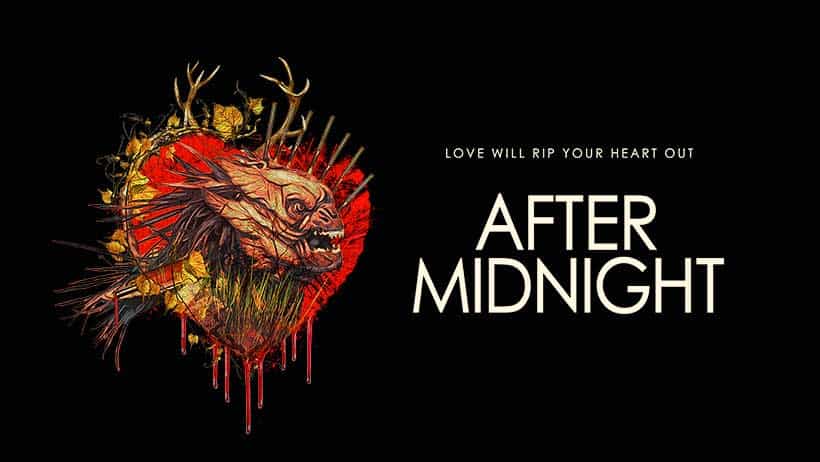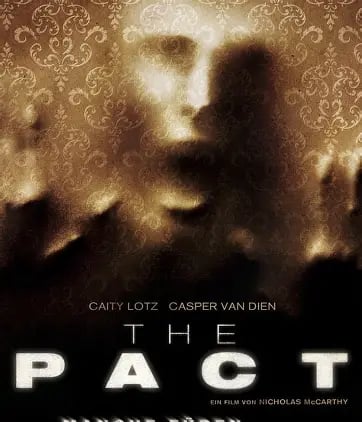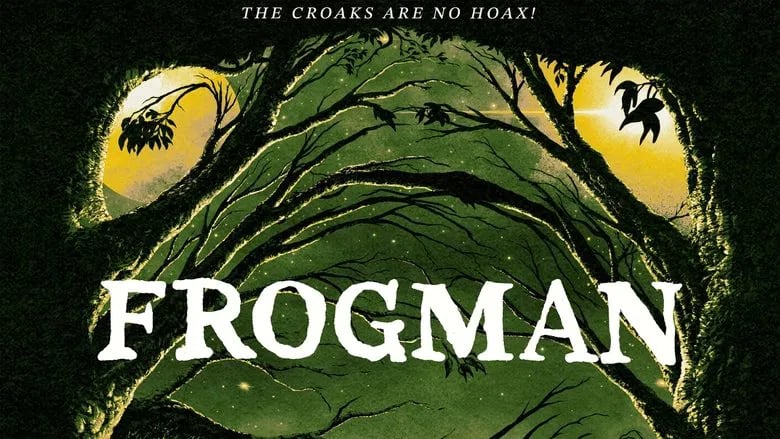Do you love dark cinema like we do?
Bloody Horror: October
Ralph Kirchoff again dives into an analysis of three modern horror films.
HORROR/SCIENCE FICTION
written by Ralph Kirchoff
10/7/20259 min read


After Midnight
Gooey romance, horror backdrop, appealing perfs, quirky script, 3.5 stars. 1HR 23Min Kavya Films, 2019
In a Rue Morgue magazine interview, Jeremy Gardner said, “I was in a long-term relationship, and I started thinking about the sacrifices that a person gives up in order to stay in a relationship …” Sounds ordinary, right? However, writer/director Gardner transformed these thoughts into the warm and entertaining horror movie, After Midnight (2019). Warm and fuzzy horror? What the heck is that? Well, this one is pretty unique, blending sweetness and romance with a horror backdrop. I’ll try to describe the characters and plot, and maybe that will give you a sense of the relationships and ideas in the film.
The film begins with electronic industrial noises as Abby (Brea Grant) wanders through an overgrown green field. She calls out for Hank (Gardner), the man she will live with for 10 years in the future, in his old rustic house. However, this is flashback territory, marking the beginning of their courtship. The house is large and badly in need of renovation. Hank comes up behind her, startling her and laughing. They walk back to the house, hand in hand.
Throughout the film, visuals shift to moments Hank remembers. The flashbacks are heartfelt, with quiet conversation, gazing, and love, all accompanied by beautiful, soft, rhythmic mellotron chords. They whisper, touch, and smile. These two are adorable together. The chemistry between Gardner and Grant is strong. But sometimes Abby appears distracted, looking past Hank, maybe beyond the relationship.
Now, scenes from the present. Hank is alone and anxious. He tells his friend Wade (Henry Zebrowski) that he has seen some kind of creature on the outskirts of his property. He says it keeps coming up to the house, and he can hear it clawing.
Hank owns a bar in the rural town of Barlow. While drinking at the bar, he convinces Wade to go hunting with him for the creature in the woods surrounding his house. But Hank is feeling dejected. He stops suddenly in the woods and tells Wade that Abby has left him. Gardner’s dialogue here shows that Hank is so overwhelmed that he might not remember things clearly. He sleeps in his living room with a shotgun. One night, he fires a shot through his creaky front door at what he thinks is the creature.
The Japanese anthology ghost film Kwaidan (1964) features an episode titled "Woman of the Snow." Snowbound men are trapped. A mysterious woman, or is she a spirit, puts them all to sleep and causes their deaths in the snow. No ... she saves one man, but only if he promises never to reveal her existence. The story was remade in a more modern setting in the horror anthology movie, Tales from the Darkside (1990), as the episode, "Lover’s Vow." You might catch a similar vibe in After Midnight now.
The present scenes are mostly silent, while the romantic flashbacks are filled with minor chords and chemistry. Gardner’s close-ups and location camera work feel intimate and involving. The script is charming, and the resolution works on multiple levels, especially romantically.
We screened the film at Gary’s Cinema Saturday club, and it didn’t go over well. My friend John Freyer didn’t like the long static scenes of dialogue. As to the resolution, my friend Charlie Wittig said it was a mind fuck. The creature design is wild, but it’s not really about the creature.
I like this one. I give it 3.5 out of 5 stars.
Frogman
Breezy found footage horror, seen not implied, light touch, satisfying watch, 3.5 stars. 1HR 17Min Rotting Press, 2023
In interviews, Anthony Cousins recounted that his first horror influences were the “crazy fever dreams” he had as a kid while watching Gremlins. Sometime later, Pet Sematary literally scared him out of the room. And though he admits that he was too young, he would watch Cronenberg’s The Fly.
His father would record horror films from TV, commercials, and all. Perhaps his love for found footage came from his ability to select and watch the videotaped films as artifacts of the times they were made.
Fast forward. He has a career in film as a crew member and has been making short films. He has always loved cryptids—creatures whose existence is debated—and when the Loveland Frogman caught his attention, “it was like a perfect storm,” and he wrote the script for his entertaining found footage horror film, Frogman. He said the found footage technique was necessary so the movie could be made within his budget.
Maybe the story in the film will pique your interest. It’s 1999, and on a road trip in Loveland with his family, 10-year-old Dallas Kyle and his sister spot an extremely large misshapen frog at the edge of the woods. It’s Frogman, and a short video is recorded on Kyle’s camcorder.
Fast forward 22 years, and we see a social media influencer explaining the background of the Loveland Frogman legend. He mentions how it was photographed in 1975 by someone named George Hale and videotaped in 1999 by Dallas Kyle. However, the influencer dismisses the legend, creating a sense of total disbelief: It’s all a hoax.
This sets up the 32-year-old Dallas (Nathan Tymoshuk) on his quest in the film to find George Hale and prove the existence of Frogman. There is a quick scene of Dallas coming across a box of old VHS tapes labeled with horror movie titles while he searches for his vintage camcorder. He gets support for the documentary from two reluctant friends, Amy (Chelsey Grant) and Scotty (Benny Barrett), who will join him on his quest, and there are the usual camcorder recordings introducing them. Dallas’ sister (who also saw Frogman in 1999) warns him to be careful, and the trip to Loveland begins.
The film has a light tone. Dallas is slightly clumsy and not taken seriously by Amy and Scotty. People often tease him, and there are many funny references to frogs. The dialogue feels natural, as if Cousins only outlined how the characters should interact, but the lines were improvised. Or so it seems. This creates engaging performances and makes for an enjoyable watch.
On the road, Amy and Scotty are having fun laughing about how unlikely it is to actually find Frogman. They arrive in Loveland, where Frogman has become a small cottage industry of tourism and souvenirs. Shopkeepers and residents all keep a tongue-in-cheek attitude. But Dallas is serious and feels the need to prove that he’s been right all along.
Well, obviously, we’re going to see Frogman. The effect isn’t awe-inspiring; it’s more like a static, rubbery monster. While it’s light and entertaining, this is supposed to be a horror movie. We will see that there’s more than cultish support for Frogman and maybe some hidden biology. There are secrets.
The cinematography uses shaky cam footage that hides low-budget visuals. There are croaking and ribbit sounds, with a windy rumble accompanying the somewhat somber ending. Aside from diegetic pop songs on the car radio, there is no music.
Cousins’ Frogman is breezy and fun. As yet, we haven’t screened it at our biweekly Bloody Horror Friday Club. I give it 3.5 out of 5 stars.
The Pact
The Pact—supernatural serial murder mystery, ghosts, clairvoyance, and Ouija tropes galore, an unwholesome backstory partially revealed, tense climax, ambiguous ending, 3 stars. 1HR 29Min Distributed by IFC Midnight, 2012.
Nicholas McCarthy’s influences included black-and-white monster movies from the 1950s and ’60s. He had a childhood fascination with supernatural horror, and William Friedkin’s The Exorcist (1973) deeply frightened him as a child. In 2011, McCarthy made a short film, The Pact, for the Sundance Film Festival. His first feature film, the suspenseful supernatural serial murder mystery The Pact (2012), is an expansion of that short, and writer/director McCarthy aimed to leave viewers with lingering questions. Since he achieved this goal, some viewers might find the film somewhat unsatisfying. I will describe the film’s plot and some of its qualities, and perhaps this feeling can be partly explained.
The film opens with a long close-up shot of a female’s green eye. The eye blinks and then turns blue. My immediate thought was... duality. There will be a person who somehow switches between different personalities.
In a house, we have close tracking shots toward a bedroom. Nichole (Agnes Bruckner) is resting, rising, and then calling her sister Annie. Nichole is in her recently deceased mother’s house. She doesn’t want to be there, and Annie doesn’t want to come. Why?
McCarthy uses soft lighting, rich wood textures, subtle printed wallpaper, and dual satin drapes. There is a feeling of comfort. What happened in this house that the sisters wouldn’t want to be there?
We see Nichole talking on the phone to Annie, and we hear Annie, but there aren’t any 2-shots. We don’t see Annie at all. This supported my duality idea. Maybe Nichole and Annie are the same person? The conversation is in her head? Well, no. Annie shows up around the seven-minute mark in the film. But the two characters aren’t ever in the same scene together.
Back to the story. In the ominous silence, shots survey the walls and hallways of the house as Nichole makes tea. Is there some entity in the house? Nichole works on her laptop and is startled when she feels something touch her neck. Moments pass. Suspiciously, she looks at an open closet door. Reluctantly, she walks toward it.
Now we meet Annie (Caity Lotz), as she mounts her motorcycle to head to her mother’s house. Nichole has disappeared! Annie will begin her lengthy investigation into her disappearance. The investigation will involve clairvoyance, ghosts, and secrets. It’s shown that Annie has one blue eye and one green eye. Victims of the Judas Killer may or may not be piling up.
When The Pact was filmed, Agnes Bruckner was a bigger and more well-known actress than Caity Lutz. Bruckner’s character disappears very early in the film, leading to a long investigation by the lead actress, Caity Lotz. I don’t understand why Lotz was cast in the lead role and Bruckner in the supporting role instead of the other way around. Could McCarthy have been influenced by Hitchcock’s Psycho and De Palma’s Dressed to Kill, where the well-known actresses in those films are shockingly victimized early on? It's a thought. However, in this film, the two actresses never share screen time. And Bruckner’s character is gone after just 6 minutes. It seems more like a contractual decision rather than a scripted one.
Whenever there's movement in the film, the echoing piano and viola create a mysterious atmosphere. There are some clever effects, like trick shots with photographs, and a ghostly presence is shown through flickering lights and people being violently moved by an invisible force. The actors are attractive; it’s cool to see Bruckner and Casper Van Dien, but apart from Bruckner, the performances lack urgency. People are disappearing! As for the misunderstood duality theme, I guess it was accidental rather than intentional.
But questions remain: What is the true relationship between Annie, Nicole, and their mother? Is the Judas Killer a ghost? What was going on in that house? The title, The Pact, what does it refer to? I believe you may find it challenging to fill in the blanks after watching the movie, but if you’re interested, I recommend watching the film first. Then come back to this article and read beyond this last page. There, I compiled a small list of ideas (beware, spoilers) from people on Internet boards. I think you’ll find most of the answers there.
I was outvoted when rating this film. To me, it feels more incomplete than mysterious, and I was going to give it 2.5 stars. But both Gary and Leo wanted to give it 3.5 stars. So, we settled on 3 stars for our biweekly Bloody Horror Friday screenings.
SPOILER ALERT! Read beyond at your own risk!
This is all Internet scuttlebutt:
Okay, the title—The Pact? What does it refer to?
The pact was between the mother and her brother, the Judas killer. She hid and protected him.
Why would the mother do that?
Here’s where the unwholesome backstory begins to take shape. Annie has heterochromia [two different colored eyes], and we see that the Judas killer does as well. So, the Judas killer is Annie’s father. However, the Judas killer is her mother’s brother, so he is also Annie’s uncle. So, the mother and brother ….
Why were the sisters so adamant about not coming to the house and staying after their mother died? What went on in that closet?
Hidden funny uncle; use your imagination.
What was the real relationship between the sisters?
The mother’s brother, the Judas killer, killed Jennifer Glick. The prevailing notion is that the mother took Jennifer’s daughter, Nichole, and raised her as her own. So, there would be no blood between Annie and Nichole.
Some people raised the possibility that the Judas Killer raped and killed Jennifer Glick and that Annie is the product of that. But deep into the film, Annie asks the Jennifer Glick ghost via Ouija, “Did my mother have a brother?” She is referring to the mother whose brother is the Judas Killer. And the Glick ghost says, “Yes.” This suggests that Jennifer Glick isn’t Annie’s mother, but Nichole’s.
Near the very end of the film, Annie is seen at the settlement, accepting a check for the sale of her mother’s house. But in the next scene, she’s in bed sleeping in that house. It’s been suggested on the Internet that the house is undergoing renovation. However, the house has been sold; she’s been paid. Why is she still in that house? To me, it just seems like the writing was not completely thought through.




Get in touch
garysvehla509@gmail.com


